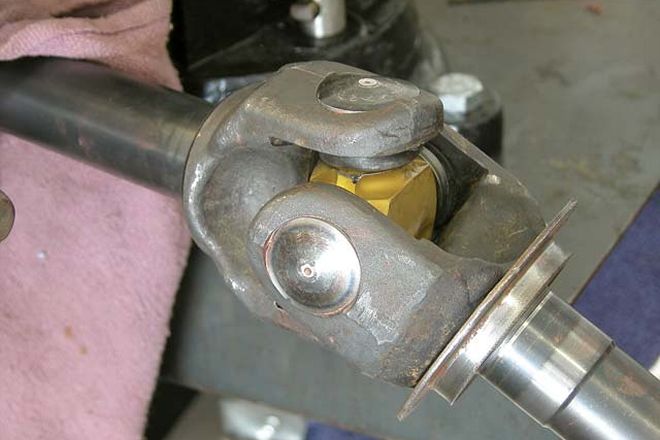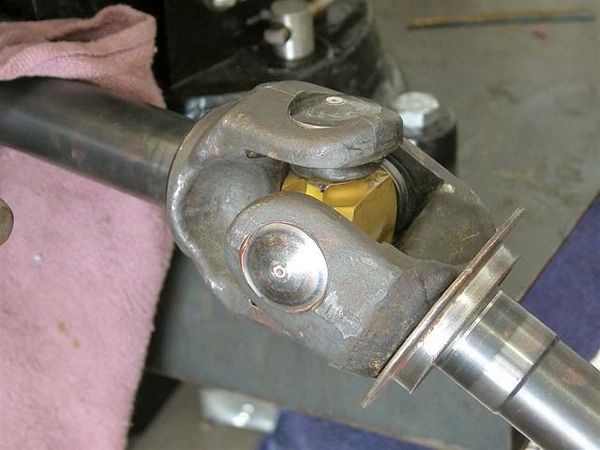
Not too many years ago, any Dana 44/GM 10-bolt size axle with 35-inch tires or larger was at the mercy of a busted U-joint and/or axle. On a hard-worked rig with low gearing, even 35-inch tires might be too much. Snap, crackle, pop ... and it ain't Rice Krispies!

Well, back in the late '90s, chrome-moly alloy front axleshafts began appearing and that solved part of the problem, but left the U-joint a lot weaker than the weakest part of the new alloy shafts. The millennium brought cures for that problem as well in the form of super-strength U-joints and, since then, the market has been expanding to offer four-wheeling consumers more choices. The newest entrant in the battle to put big axle beef into small axles is the Yukon Gear Super Joint.
The cross is built of thru-hardened 4340 chromoly with a titanium nitrate coating (the gold color), giving it super wear characteristics by reducing the coefficient of friction. This allows it to ride directly in the induction-hardened 4140 chromoly cap with very tight clearances and without a separate bushing or needle bearings. Needle bearings are one of the main weak links of conventional U-joints. Because they have more clearance, the roller bearings can get cocked under a heavy load as the cross distorts slightly. That will often shatter the needle bearings, pop the clips, move the cap and begin the major failure event. Without the need for a separate bushing or needle bearings, the trunnion can be made larger in diameter as well, adding to overall strength. The trunnion on the Super Joint is some 5 percent larger than a Dana 60 joint (0.935 versus 0.892 inches).
Still, a needleless or bushed U-joint is not for every four-wheeler. Needleless and bushed U-joints do not wear as well long term as those with roller bearing caps. Yes, frequent lubrication helps, but long life is the trade-off for brute strength. You definitely would not want to use a needle-less joint on full-time 4WD rigs, or a part-time rig that is used in four-wheel high often. To answer these applications, Yukon is designing a Super Joint model with needle bearings. It will be somewhat weaker than the current unit, but easily stronger than a standard U-joint. Yukon has a lifetime warranty against breakage on the current model.
Yukon injects some interesting design elements to counter the inherent wear issues of a needleless joint. The slippery titanium coating is one. A lube chamber with a spring-loaded piston is another. When you push grease into the joint at each of the four caps, the piston and spring compress and it holds a reservoir of grease under pressure. This continually feeds lubrication to the cap and trunnion over a longer period and wear is reduced. A special 200,000-psi compressive strength copper-based grease and a nifty little grease gun is included with each set of Yukon Super Joints. It's the only grease you should use in the Super Joint.
As with any of the super-strength joint manufacturers, Yukon recommends installing them only on high-strength alloy front shafts, either those from Yukon Gear or another manufacturer. They are compatible with all current manufacturer's alloy front shafts. Installing them on standard front shafts is not recommended. The full circle clips supplied will not fit an OE axle anyway, and hopefully that will keep people from doing something stupid.
Yukon Gear currently offers U-joints to replace the 297-sized ones found in many axles (Dana 44, GM 10-bolt front, some Dana 30s and a few others) and a Dana 60-sized 332 size joint is close to completion. A 260 size is on the drawing boards.
The downfall of installing a big, beefy front axle has always been that it's, well, big. Weight is increased and clearance is decreased, plus there's all the swapping issues to contend with. With fullsized rigs, swapping in a Dana 60 is not a big technical issue. With smaller rigs, for the aforementioned reasons and others, it can be a huge one. That's why the alloy shafts and super-strength U-joints have become such an important equalizer because you can have an axle nearly equal in strength to the D60 but in a lighter and more compact size. This applies to Dana 44/GM 10-bolt sizes as well as Dana 30s, Toyotas and some other axles as well.
Keep in mind that beefing an axle is a holistic exercise, meaning you have to think of the whole axle rather than just a few of its parts. When you increase the strength of one part radically, you are putting another one at risk. The idea is to have all parts at about an equal level, ideally with the most easily replaced part as the weakest. This is exactly what the OE manufacturer did, as you will see below, alongside some averaged results for aftermarket products.
Note: Dana 44-sized components used for illustration purposes. Tensile strength (when it breaks) shown.
Stock Strength Aftermarket Strength297 U-Joint 4,{{{600}}} lb-ft (3) 10,000 lb-ft (3)Outer Axle (4) 2620 lb-ft (*)(1) 6,000 lb-ft (*)(2)Inner Axle (5) 2610 lb-ft (*)(1) 6,595 lb-ft (*)(2)Carrier, 2-pinion (6) +60 percent (7)Carrier, locker +{{{100}}} percent (8)Ring-and-pinion (9) (9)Locking Hub 3,{{{300}}} lb-ft (10) 5,400 lb-ft (10)(*)= Values calculated from typical materials1. SAE 1040 carbon steel
2. SAE 4340 alloy steel
3. Values based on similar destructive testing. The OE manufacturer's rating for a 1310 series, 297-size joint is much lower ... about 1,600 lb-ft. This lower number is the point where permanent deformation begins to occur.
4. Minimum diameter 1.10 inches at splines.
5. Minimum diameter, 1.10 inches at the necked-down section. A non-necked 30-spline axle (1.21 inches minor spline diameter) of the same material would be approximately 30 percent stronger.
6. We have to assume that the OE carrier is of similar strength to the rest of the components, but we could not find an engineer to give us a useful number.
7. The choice shown here is a high-quality, two-pinion aftermarket limited slip, because few significantly stronger-than-stock aftermarket open carriers are built. All of this is really tricky to calculate. After polling engineers and experts, we finally decided to put down an average based on the improvements found on a typical aftermarket carrier made of a higher-quality-than-OE ductile cast iron and made some stouter by design. Some OE carriers are very stout, some are not, so the benefits could vary.
8. Many lockers use a high-grade forged steel in their construction, which may put them at an even higher strata than the best cast iron. Again, this estimate based on comparing materials and design.
9. Since the OE and the aftermarket both generally use SAE 8620 alloy steel, assuming no flaws, the OE and aftermarket are essentially equal in terms of strength. There may be other issues of quality, but that's another discussion. The biggest strength factor in the medium-sized ring-and-pinions (around 8.5 inches) is the gear ratio. Ratios lower than 4.56:1 tend to reduce the strength of the gearset because there are fewer teeth on the pinion. The more teeth the pinion has in mesh with the ring gear, the stronger the gearset, and vice versa.
10. Based on industry averages. Some units may be higher or lower.








